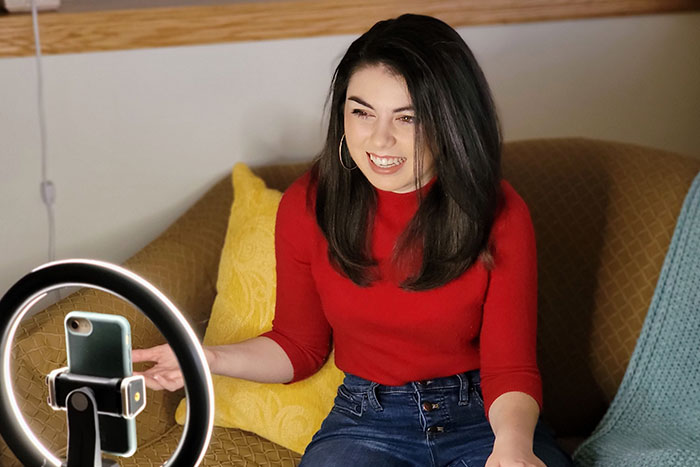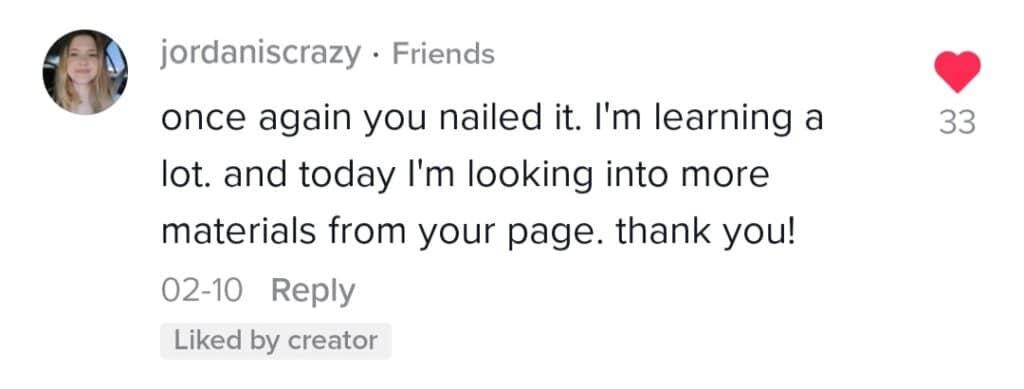I love my colleagues at ERI. We pride ourselves on innovation and flexibility, so you’ve probably noticed that we’re constantly experimenting with new arguments, formats, video styles, designs, etc. But here’s the thing: we’re a really small team, so when we determine we need a new strategy, a new program, or a new whatever, that means one of us has just gotta figure it out! We’re go-getters, so when we see something that needs to get done, we’ll find a way.
Enter TikTok.

(Behind-the-scenes photo of me TikToking)
Estimated reading time: 13 minutes
I have zero social media training. I’m 23 years old, and before I joined the ERI staff I had a Facebook…yep, just a Facebook. That Facebook, mind you, I posted on approximately once a year. I had about as much knowledge on how to succeed on social media as a goldfish does on how to do the macarena. As far as I was concerned, TikTok was this wacko app where teenagers went viral from dance routines they made up in their parents’ basement. But, “the youth” are on TikTok, and I have a passion for reaching the youth of the pro-life movement, so when our supporters started asking questions about when we were going to get on TikTok, I looked at the team and said “you know what…let’s do it! I’ll figure it out!”
It was right before Christmas 2021 when I finally had a few freer days in my work schedule to do some research. I downloaded TikTok on my phone and spent two days watching every YouTube video on “how to succeed on TikTok” I could get my hands on. That’s when my go-getter attitude started waning; conquering the TikTok algorithm seemed like aimlessly throwing wet spaghetti at a wall—after spinning around 20 times blindfolded—and just praying that something sticks.
My Feelings Evolved…A Lot
January 16th, 2022. The first day I made a TikTok video, my optimism for the likelihood of ERI succeeding on this platform was zero. Actually, below zero. I could find ridiculously few pro-life TikTok creators—at least compared to the hundreds of pro-life organizations hanging out on other social media platforms—and almost none of them had a major following. And while TikTok does allow you to make videos longer than one-minute, I quickly learned that no one watches those. Once a video passes the 60 second mark, TikTok disables the ability for viewers to share the content via “duets” and “stitches,” which basically means the likelihood of the algorithm picking up your long video and showing it to anyone is extremely low. Throwing wet spaghetti at a wall? More like nailing jello to a wall.
So, it’s got to be less than 60 seconds. But how was I supposed to say anything valuable about abortion in less than one minute?! Writing scripts for our Quick Response YouTube series—where each video had a self-imposed five-minute limit—had already been a frustrating task for an organization that places so much emphasis on nuance, dialogue, and intelligent arguments rather than slogans, monologues, or soundbites. One-minute? That just seemed impossible.
My first few videos were an epic experiment. I bopped around my house to music, talked to my camera on a walk outside a la the vlogging days, did live reactions to memes posted on a green screen behind me…and then I stumbled on the golden ticket. We were preparing to leave for the March for Life, so I was down in Charlotte, NC in my colleague Jen’s living room when I filmed a quick TikTok about the Sovereign Zone argument, but instead of talking about it, I demonstrated it. I set up my phone and played both roles in a practice dialogue—both the pro-choice person’s statements and the pro-lifer’s responses—by splicing together videos filmed from different angles. I then typed instructions on screen for pro-lifers to follow along with how “pro-life Emily” was making her argument, and I timed each written instruction to appear precisely when I was verbally demonstrating that step. I hit “post,” we jumped in the car, and I didn’t check my phone again until hours later when I opened my notifications bar to see over 11,300 views, 1,500 likes, and 378 comments. Yeah, I know 11,300 views is far from “going viral,” but I had cracked the code. I’d found our niche. I’d stumbled on the thing no other pro-lifers were doing on TikTok, and it turns out that people were craving it.
Over 1 Million Views Later
The ERI account is different from the rest of TikTok, and that is precisely why I believe we’re succeeding. Making a coherent argument about literally anything is almost impossible on TikTok (more on that later), so when I was not only making coherent arguments myself but teaching pro-lifers how to make my arguments in a systematic way, people freaked out. Our account’s stats skyrocketed, and I could tell you what happened, but it’s more fun if I let our followers tell you:




So, What Have I Learned?
All that’s to say, I still think TikTok is a weird place, but it’s a weird place that works. What makes it tick, and how can you leverage that to have a successful pro-life presence on the platform?
1. TikTok humanizes you, so take advantage of it.
My number one frustration with social media dialogue is that it dehumanizes your opponent. Note, I never call the pro-choice person I’m dialoguing with my “opponent”…except in this context, because that’s exactly how it feels. Social media is strategically designed to reinforce confirmation bias and give you the illusion of anonymity to scream at the “idiots on the other side.” I can’t possibly think of the young women I’m chatting with on a college campus as my “opponents” because I can see their smiles, and I can relax my body language, and within two minutes I’ve brought their walls down. We look like some friends chilling after class, not abortion debaters fighting to the death. But on social media, I can’t see them, and they can’t see me. All nuance is lost, and everything I type could come across as a snarky quip since they can’t hear my voice.
TikTok avoids those problems, if you know how to take advantage of it. Many TikTok creators wear costumes to avoid showing their faces, they use still images with text on screen, or they show their face but never talk aloud in favor of choreographed pointing at text bubbles timed to music. Honestly, I think all of those are pretty unhelpful strategies. Now, I’m not telling you how to succeed on TikTok promoting floral arrangements or workout routines; I’m telling you how to change minds about abortion, and that means humanizing yourself is key.
TikTok is an anti-aesthetic platform. Instagram is all about your polished “look,” from color-schemes to filters, but Gen-Z has ditched photoshop in favor of “authenticity.” I bought a $15 cell phone light stand, and I make videos around my house, in the car, in my hotel rooms on speaking trips, or really wherever! I even made one in the airport once. Sometimes I’ll put a tiny text bubble in the corner just to tell people where I am or what I’m up to (like “I’m hanging out speaking at the Oregon Right to Life Conference today! Sorry for the weird audio!”). I’m clearly not in a fancy studio; I’m a real person with a real life, and my viewers get a window into that. Pointing out common ground in controversial conversations is absolutely key to effective dialogue, and so too is pointing out common experiences. When a pro-choice person sees my 5’ 1”, 23 year-old self, I’m suddenly not some abstract weirdo pro-lifer; I’m actually a lot like them. I’m normal! Remember when you were eight years-old and mind-blown that you ran into your teacher at Walmart? You had this strange mental confidence that teachers just “lived at school?” Same concept. TikTok shows the world that I wear the same clothes pro-choice people do, I know how to crack a joke, and I even go to the grocery store, too! TikTok makes it easy to humanize yourself just by being yourself on camera—that means showing your smile, using your voice, and showing your messy house every once in a while.
But you’re not a TikTok creator? No problem. Instead of typing your responses to the pro-choice comments under my videos, try making a video reply! Quick shout-out to the thousands of pro-lifers who regularly comment on my TikTok videos and engage with the pro-choice people who found my videos in their feed: thank you! You’re awesome, and I appreciate your dedication to helping boost my videos in the TikTok algorithm while trying to promote productive dialogue. Instead of typing out your comment though, try filming yourself speaking it in a video; all you have to do is click the “video reply” button rather than the “reply” button under a comment! Video replies will not only put a real person behind your incredibly random username like @superslider08, but they’ll keep the conversation more cohesive too because…
2. It’s insanely easy to lose the plot.
And I thought Twitter was hard! Twitter is famous for its 280-character limit, which makes writing posts with any substance legitimately difficult. Users typically get around that limit by stringing several comments together in a chain, and that more or less does the trick for finishing a thought before someone else jumps in. That does not work well on TikTok, though.
TikTok has a 150-character limit; that’s basically a sentence and a half. It’s pathetic. I’ve already written over 150-characters just since the beginning of this paragraph! Anytime you have more than two words to say, you have to try stringing several comments together, but it takes so many comments and so long to type them all that you’ve only had time to say:
 before fifty other people have jumped on your comment and never let you finish your thought (or if you ever try to finish, the second half of your thought is now buried in a sea of comments, so anyone finding it and putting your two halves together is virtually hopeless). When a pro-choice person makes a comment on my channel, there are almost instantly hundreds of replies.
before fifty other people have jumped on your comment and never let you finish your thought (or if you ever try to finish, the second half of your thought is now buried in a sea of comments, so anyone finding it and putting your two halves together is virtually hopeless). When a pro-choice person makes a comment on my channel, there are almost instantly hundreds of replies.

There is basically no way to understand what the other side is saying because they either have to poorly explain their position in a bare-bones 150-character version or fully flesh-out their position over multiple comments you’ll never be able to locate. The comments section looks like someone took a novel, wrote one sentence on each of a million pieces of paper, blindly scrambled them while ripping a few sentences in half in the process, and now you’re expected to make sense of the plot line.
TikTok is also unique because new people are constantly stumbling across your content. In contrast to Facebook, Twitter, or Instagram—where your home page “feed” is made up of exclusively people you follow and posts they’ve liked/commented on/shared—the home page “feed” on TikTok isn’t always made up of people you’re already following. Instead, your “feed” consists of popular things the algorithm thinks you’ll be interested in based on past behavior. So, if you commented on a pro-choice tiktok yesterday, the algorithm will toss you my video today. That means there are always new eyes on my content, which is awesome, but you’ve got to remember: there are new people commenting who don’t yet understand what this channel is about, and they certainly haven’t seen all my other videos. I might have literally just responded to the “back-alley abortion” argument yesterday, but this new person doesn’t know that! You should always give extra charity and grace in online conversations since you can’t hear people’s inflection and see their intentions, but TikTok conversations are a whole different breed. The pro-choice commenter just got dropped here like a fish out of water, so please don’t bombard them with “she literally just responded to that yesterday, look before you comment dude!!” Yes, you should respond to them, and yes, you can direct them to check out my other videos, but 150-characters isn’t an excuse to be obnoxious about how you do it.
Consider sending them a private chat message after you briefly answer their question or concern. Let them know that my channel is a place where dialogue about abortion is welcomed, and I make a video reply to one pro-choice comment every day, so they are always free to comment on my videos.
3. Evaluate your priorities.
This is where I struggle. While our channel has received hundreds of positive comments, not everyone is a fan.
 I genuinely wish that I had the time to respond to all the comments we receive. For commenters like this one, I’m sorry I haven’t personally responded to your comments, but you and I both have to know that’s not physically possible. In just eight weeks on TikTok, we’ve received 12,554 comments. That’s an average of 179.3 comments per day. Even if I did the 150 character-version of a response to every single one, I’d still never finish, and then each of those people would reply back to me…and I’ve already talked about why endless comment chains in TikTok are impossible to track. So I’d like to make a video reply to every pro-choice comment, but I have to keep myself healthy—and so do you! That’s why I pick one comment every day to make a video reply to; I will not let myself enter the black hole of endless scrolling. I choose the comments I respond to very carefully, focusing first on the types of comments I’m seeing most often, then on the particularly interesting or well-thought-out ones, and lastly on categories of pro-choice arguments I haven’t addressed in a while. I definitely don’t just pick the easy comments; responding to the hundreds of comments I get on Judith Jarvis Thomson’s Violinist thought-experiment is hardly “low hanging fruit.” Even then, I’m not physically capable of even reading all of the comments that come in, so there’s a good chance I haven’t seen yours! I have to keep my life’s priorities in balance, and you should too, regardless of what social media platform you’re on. Pro-lifers: please do respond to pro-choice people on TikTok, but don’t spend your life there.
I genuinely wish that I had the time to respond to all the comments we receive. For commenters like this one, I’m sorry I haven’t personally responded to your comments, but you and I both have to know that’s not physically possible. In just eight weeks on TikTok, we’ve received 12,554 comments. That’s an average of 179.3 comments per day. Even if I did the 150 character-version of a response to every single one, I’d still never finish, and then each of those people would reply back to me…and I’ve already talked about why endless comment chains in TikTok are impossible to track. So I’d like to make a video reply to every pro-choice comment, but I have to keep myself healthy—and so do you! That’s why I pick one comment every day to make a video reply to; I will not let myself enter the black hole of endless scrolling. I choose the comments I respond to very carefully, focusing first on the types of comments I’m seeing most often, then on the particularly interesting or well-thought-out ones, and lastly on categories of pro-choice arguments I haven’t addressed in a while. I definitely don’t just pick the easy comments; responding to the hundreds of comments I get on Judith Jarvis Thomson’s Violinist thought-experiment is hardly “low hanging fruit.” Even then, I’m not physically capable of even reading all of the comments that come in, so there’s a good chance I haven’t seen yours! I have to keep my life’s priorities in balance, and you should too, regardless of what social media platform you’re on. Pro-lifers: please do respond to pro-choice people on TikTok, but don’t spend your life there.
Social media is great, but it’s not enough.
TikTok is the weirdest app I’ve ever seen. There’s incredible opportunity to engage face-to-face with thoughtful people on the other side, and I want to use the platform to start a conversation, but by no means do I want to finish it there. Changed minds on TikTok do happen, but that’s not why I’m there. I believe that my videos can provide a new perspective for pro-choice people, humanize the pro-life position, and give pro-life people tools to go have those in-person conversations that actually change hearts and minds. That’s my favorite kind of comment to see: one that tells me that pro-lifers are learning and growing because of my channel. They’re gaining confidence and resources to think clearly, reason honestly, and argue persuasively on their own. Social media will never replace the power of an in-person conversation, and the sooner you come to grips with that, the more effective you’ll be. You’ll learn to make your online conversations like an in-person conversation, and you’ll be ready when those in-person ones come your way. If my channel can just start a few of those conversations by giving you step-by-step instructions and a new way of thinking about abortion, mission accomplished.


Please tweet this article!
- Tweet: The Chronicles of Abortion Dialogue on TikTok, the Weirdest App I’ve Ever Seen
- Tweet: So, it’s got to be less than 60 seconds. But how was I supposed to say anything valuable about abortion in less than one minute?!
- Tweet: In order to change minds about abortion, humanizing yourself is key.
- Tweet: You should always give extra charity and grace in online conversations since you can’t hear people’s inflection and see their intentions, but TikTok conversations are a whole different breed.
- Tweet: Changed minds on TikTok do happen, but that’s not why I’m there.
The post The Chronicles of Abortion Dialogue on TikTok, the Weirdest App I’ve Ever Seen originally appeared at the Equal Rights Institute blog. Subscribe to our email list with the form below and get a FREE gift. Click here to learn more about our pro-life apologetics course, “Equipped for Life: A Fresh Approach to Conversations About Abortion.”







Please note: The goal of the comments section on this blog is simply and unambiguously to promote productive dialogue. We reserve the right to delete comments that are snarky, disrespectful, flagrantly uncharitable, offensive, or off-topic. If in doubt, read our Comments Policy.